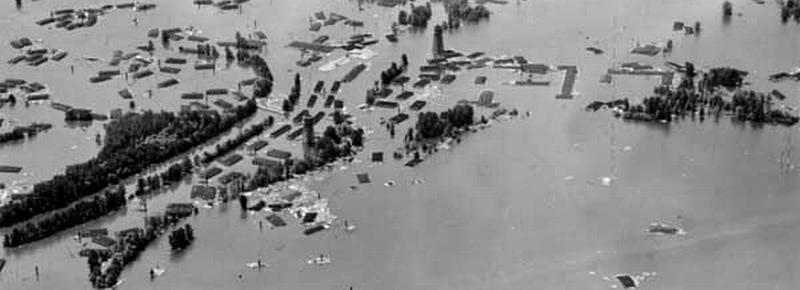
Vanport Flood 1948
In recent protests in Portland, the white nationalist group Proud Boys assembled on the edge of town in Delta Park, while, close by, Black Lives Matters counter-protestors gathered, on the other side of the highway, in a section of the park referred to as Vanport. Although little is left beyond the name, Vanport is part of the history of the struggle for racial justice that still resonates in Portland and so much of the nation today.
Built in just 110 days in 1942, Vanport was a housing project meant to provide shelter for 40,000 shipyard workers, who came to Portland to work in the three nearby Kaiser shipyards, building Liberty and Victory ships, as well as aircraft carriers, tankers, and landing ships, to support the war effort. Kaiser’s Northwest shipyards produced 752 ships during the war years and Vanport soon became the second-largest city in Oregon.
From the historical marker: Nicknamed Kaiserville, most Vanporters lived in one-bedroom apartments. There was a library, post office, police station, infirmary, public cafeteria, stores, and a 750-seat movie theater. While most Americans had no medical insurance, Kaiser’s workers enjoyed a prepaid health plan. After the war, the plan and its doctors became the Kaiser Permanente medical and dental care program.
There was another side to Portland and to Vanport. Given a general labor shortage, Blacks, as well as Native Americans, and women were hired by the Kaiser shipyards. The Black population of the Portland area rose tenfold, from 2,000 in 1940 to 20,000 by 1945.
This proved to be a problem for Portland because the city and the state of Oregon had a long-established history of excluding black residents. The first law excluding Blacks from the state was enacted in 1844. Oregon entered the Union in 1859 as a “whites-only” state. The original state constitution banned slavery but also excluded nonwhites from living there. The exclusionary laws remained on the books until 1922.

When Black workers arrived in Portland they found that Jim Crow practices had followed them to the Northwest. The Kaiser shipyard Boilermaker’s Union refused to allow skilled Black workers into the union. The only shipyard jobs available to Blacks were as helpers and cleaners. Skilled Black welders and fitters were allowed to join an “auxiliary union” where they were paid less, had no union privileges, but were expected to pay the same union dues as white workers. Many Blacks refused to join the auxiliaries.
The workers complained. Kaiser and the unions should have been bound by Roosevelt’s Executive Order 8802: Prohibition of Discrimination in the Defense Industry, which notionally barred racial discrimination.
Oregon Kaiser shipyards fired more than 300 black workers in July 1943 for refusing to join the auxiliary. The Fair Employment Practices Commission (FEPC) held public hearings and issued a “cease and desist” order, with little result. In 1944, further intervention in courts by the FEPC resulted in a favorable ruling. By then, the war, and shipyard production, was almost over.
After the war, the shipyards shut down and the population Vanport shrank by half. For many long-time Portland residents, Vanport was known as the “Negro Project” despite the fact that African Americans were no more than 25% of residents at any given time.
Then on May 31, 1948, a railroad dike on the Columbia River broke causing a flood that effectively wiped Vanport off the map. In just over a day, Vanport was gone.
As noted by the BlackPast blog: Despite its short life span, Vanport helped create several “firsts” for Oregon and the Portland area. The first black teachers and policemen in the state were hired in Vanport during the war years. The Vanport Interracial Council worked to establish a Portland office of the Urban League. Vanport College was the precursor to Portland State University where many veterans used the GI Bill to get a new start on life. In the end, Vanport became part of the story of civil rights and African Americans in the West.

Another part of our history that spent too long in the shadows.
I am not sure the “Proud Boys” can be considered a white nationalist group, when their leader is Black.
My uncle was living at Vanport when it flooded. It was home to some of the first integrated schools in the country, where the Black students were definitely a minority. Vanport was made up of approximately 26,000 Whites and 6,000 Blacks and no Japanese. Less than a mile away, the Portland Stockyards was being used as a gathering center for the Japanese residents of the Pacific Northwest who were then sent to the internment camps.
https://www.oregonlive.com/portland/2017/02/portland_japanese_internment.html
The FBI now classifies the far-right Proud Boys as an “extremist group with ties to white nationalism”, according to a document produced by Washington state law enforcement.
https://www.theguardian.com/world/2018/nov/19/proud-boys-fbi-classification-extremist-group-white-nationalism-report
That is a November 2018 article. December 2018 says: “The FBI says the Proud Boys are not an extremist group after all”. Politics aside, thank you for the article. I thought everyone living in this area knew this history. Just found out many 40 year olds in this area with Kaiser Permanente Health Insurance, don’t know the background of the name.
History should be taught more in schools, it is often perceived as not necessary but, for example, if more US citizens were aware of the similarities between the economic situation and social status in your country and that of France before the revolution you could see which direction things are headed.